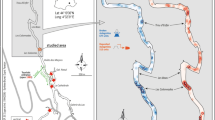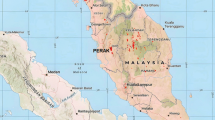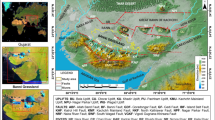Abstract
The territory of Brazil has a high potential for the development of geotourism, due to its natural and cultural diversity. The State Tourist Park of Alto Ribeira (PETAR) is one of the oldest protected areas in the State of São Paulo, created in 1958. The importance of the area is the result of the association between the Atlantic Rainforest with an exceptional biodiversity and karst and caves systems with a unique underground scenario. The area presents distinct tectonic environments that represent the Precambrian geological evolution of south-southeastern Brazil. The karst and caves of the PETAR were already recorded and described as an important national area to the speleological, geological, and paleontological interest, as also classified as UNESCO’s Natural Heritage and included in a proposal to the creation of a Geopark. In the present work, there were inventoried and quantified 19 geosites in the region of PETAR, most of them with speleological interest. The inventory was conducted using the following criteria: representativeness, integrity, accessibility, and scientific and esthetic value. The quantification of geosites was based on four categories of values: intrinsic value, scientific value, tourism value, and value of management. Finally, the relevance of each geosite was calculated, evidencing one geosite with international (Santana cave) and other 12 with national relevance. The conclusions raise the necessity of planning and implementing management procedures to increase the conservation and sustainable use of the analyzed geosites, despite that they are located in a natural protected area.






Similar content being viewed by others
References
Almeida FFM (1977) O Cráton do São Francisco. Revista Brasileira de Geociências 7:349–364
Borsanelli FA, Lobo HAS (2015) Impactos causados à comunidade local com o fechamento das cavernas turísticas do PETAR em 2008 na visão dos stakeholders envolvidos. Anais do 33° CBE. Campinas:719–727
Brasil (2000) Sistema Nacional de Unidades de Conservação – SNUC. Congresso Nacional, Brasília
Brazilian Geological Survey (CPRM) (2018) Sistema de cadastro e quantificação de geossítios e sítios da geodiversidade. CPRM. https://www.cprm.gov.br/geossit/. Accessed 10 August 2018
Brilha J (2005) Patrimônio geológico e geoconservação: a conservação da natureza na sua vertente geológica. Palimage Editores, Viseu
Brilha J (2016) Inventory and quantitative assessment of geosites and geodiversity sites: a review. Geoheritage 8:119–134
Campanha GAC, Basei MAS, Faleiros FM, Nutman AP (2016) The Mesoproterozoic to Early Neoproterozoic passive margin Lajeado Group and Apiaí Gabbro, southeastern Brazil. Geosci Front 7:683–694
Cigna AA, Burri E (2000) Development, management and economy of show caves. Int J Speleol 29:1–27
Cruz FW, Burns SJ, Karmann I, Sharp WD, Vuille M, Cardoso AO, Ferrari JA, Silva Dias PL, Viana O Jr (2005) Insolation-driven changes in atmospheric circulation over the past 116 ky in subtropical Brazil. Nature 434:63–66
Dowling RK (2011) Geotourism’s global growth. Geoheritage 3:1–13
Faleiros FM, Campanha GAC (2004) Petrografia e microestruturasde tectonitos da Zona de Cisalhamento Ribeira, Vale do Ribeira, SP e PR: implicações no zoneamento metamórfico e estrutural do Supergrupo Açungui e unidades correlatas. Revista Brasileira de Geociências 34:419–430
Fundação Florestal, Ekos Brasil (2010) Plano de manejo espelológico do Parque Estadual Turístico do Alto Ribeira. Secretaria do Meio Ambiente, São Paulo
Forti P, Galli E, Rossi A (2000) New rare cave minerals from the Perolas-Santana karst system (São Paulo State, Brazil). Int J Speleol 29:127–150
García-Cortéz A, Carcavilla-Urquí L (2009) Documento metodológico para la elaboración del inventario español de lugares de interés geológico (IELIG). Instituto Geológico y Minero de España, Madrid
Garcia MGM, Brilha J, de Lima FF et al (2017) The inventory of geological heritage of the State of São Paulo, Brazil: methodological basis, results and perspectives. Geoheritage 10:239–258
Gillieson D (2011) Management of caves. In: Van Beynen P (ed) Karst and cave management, springer, pp141–158
Grandgirard V (1999) Switzerland - the inventory of geotopes of national significance. In: Vallejo M, Gallego E (eds) Barettino D. Towards the balanced management and conservation of the geological heritage in the new millennium, Sociedad Geológica de España, pp 234–236
Gray M (2004) Geodiversity: valuing and conserving abiotic nature. John Wiley and Sons, Chichester
Hasui Y, Carneiro CDR, Coimbra AM (1975) The Ribeira folded belt. Revista Brasileira de Geociências 15:257–266
Henriques MH, Reis RP, Brilha J, Mota T (2011) Geoconservation as an emerging geoscience. Geoheritage 3:117–128
Karmann I (1994) Evolução e dinâmica atual do sistema cárstico do alto Vale do Rio Ribeira de Iguape, sudeste do Estado de São Paulo. Universidade de São Paulo, Thesis
Karmann I, Ferrari JA (2002) Carste e Cavernas do Parque Estadual Turístico do Alto Ribeira (PETAR), SP – Sistemas de cavernas com paisagens subterrâneas únicas. In: Schobbenhaus C, Campos DA, Queiroz ET, Berbert-Born M (eds) Sítios geológicos e paleontológicos do Brasil. DNPM/CPRM, pp 401–413
Labegalini JA, Auler AS (1997) Caverna Santana, Brazil. In: Hill CA, Forti P (eds) Cave minerals of the world. National Speleological Society, pp 340–342
Lima FF (2008) Proposta metodológica para a inventariação do patrimônio geológico brasileiro. Universidade do Minho, Thesis
Lima FF, Brilha JB, Salamuni E (2010) Inventorying geological heritage in large territories: a methodological proposal applied to Brazil. Geoheritage 2:91–99
Lobo HAS (2015) Tourist carrying capacity of Santana cave (PETAR-SP, Brazil): a new method based on a critical atmospheric parameter. Tour Manag Perspect 16:67–75
Lobo HAS (2017) Entre 117 e 1344: qual o limite diário recomendável para a visitação da caverna Santana (PETAR-SP)? Revista Brasileira de Ecoturismo 10:645–669
Mansur KL, Rocha AJD, Pedreira A et al (2013) Iniciativas Institucionais de valorização do patrimônio geológico no Brasil. Boletim Paranaense de Geociências 70:2–27
Moreira JC (2008) Patrimônio Geológico em Unidades de Conservação: atividades interpretativas, educativas e geoturísticas. Universidade Federal de Santa Catarina, Thesis
Nascimento MAL, Ruchkys ÚA, Mantesso Neto V (2008) Geodiversidade, Geoconservação e Geoturismo: trinômio importante para a proteção do patrimônio geológico. Sociedade Brasileira de Geologia, São Paulo
Pereira RGFA (2010) Geoconservação e desenvolvimento sustentável na Chapada Diamantina (Bahia–Brasil). Universidade do Minho, Thesis
Pnud – Programa das Nações Unidas para o Desenvolvimento (2010). Índice de desenvolvimento humano. IBGE. https://cidades.ibge.gov.br. Accessed 5 march 2018
Ruchkys UA (2007) Patrimônio geológico e geoconservação no Quadrilátero Ferrífero, Minas Gerais: potencial para a criação de um geoparque da UNESCO. Universidade Federal de Minas Gerais, Thesis
Ruchkys UA, Machado MMM (2013) Patrimônio geológico e mineiro do Quadrilátero Ferrífero, Minas Gerais – Caracterização e iniciativas de uso para educação e geoturismo. Boletim Paranaense de Geociências 70:120–136
Santos P, Brilha J (2016) Base studies for the promotion of a highquality geotourism in the Tourist State Park of Alto Ribeira (Brazil). Proceedings of 7th International Conference on UNESCO Global Geoparks, Torquay, pp 241
Schobbenhaus C (2006) Projeto Geoparques: proposta de projeto. CPRM. http://www.cprm.gov.br/publique/cgi/cgilua.exe/sys/start.htm?sid=134. Accessed 2 June 2014
Schobbenhaus C, Silva CR (2012) Geoparques do Brasil: propostas. CPRM, Brasília
Sharples C (2002) Concepts and principles of geoconservation. Tasmanian Parks & Wildlife Service, Tasmania
SBE – Sociedade Brasileira de Espeleologia (2018) Cadastro Nacional de Cavernas. SBE. http://www.cavernas.org.br Accessed in 5 December 2017
Theodorovicz A (2014) Geoparque Alto Vale do Ribeira: proposta. CPRM, Brasília
Uceda AC (2000) - Patrimonio geológico; diagnóstico, clasificación y valoración. Jornadas Sobre Património Geológico y Desarrollo Sostenible, Soria, pp. 23–37
Unesco (1999) Atlantic forest south-east reserves. Unesco. http://whc.unesco.org/en/list/893. Accessed 15 February 2018
Wall G, Mathieson A (2006) Tourism: change, impacts, and opportunities. Pearson Education, New Jersey
Wimbledon WAP (1996) Geosites – a new IUGS initiative. Episodes 19:87–88
Wimbledon WAP (2011) Geosites – a mechanism for protection, integrating national and international valuation of heritage sites. Geologia dell’Ambiente 2:13–25
Funding
The research that initially generated the data from this article was supported by the State University of São Paulo (Universidade Estadual Paulista—Unesp) and was funded by CAPES (Coordenação de Aperfeiçoamento de Pessoal de Nível Superior—Coordination for Enhancement of Higher Education Personnel). Additional researches were made with support and funding of CNPq (Conselho Nacional de Desenvolvimento Científico e Tecnológico—National Council for Scientific and Technological Development).
Author information
Authors and Affiliations
Corresponding author
Rights and permissions
About this article
Cite this article
Ferreira, A.R.R., Lobo, H.A.S. & de Jesus Perinotto, J.A. Inventory and Quantification of Geosites in the State Tourist Park of Alto Ribeira (PETAR, São Paulo State, Brazil). Geoheritage 11, 783–792 (2019). https://doi.org/10.1007/s12371-018-0331-y
Received:
Accepted:
Published:
Issue Date:
DOI: https://doi.org/10.1007/s12371-018-0331-y




